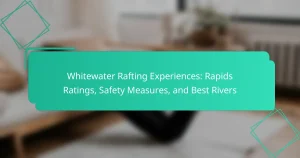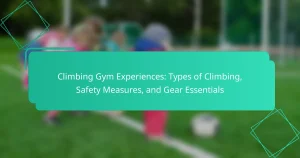Kiteboarding offers thrilling experiences, but success depends on understanding wind conditions, essential equipment, and safety practices. Ideal wind ranges from 12 to 25 knots enhance performance. Key gear includes a kite, control bar, harness, and safety leash. Adhering to safety guidelines and local regulations ensures a secure and enjoyable kiteboarding adventure.
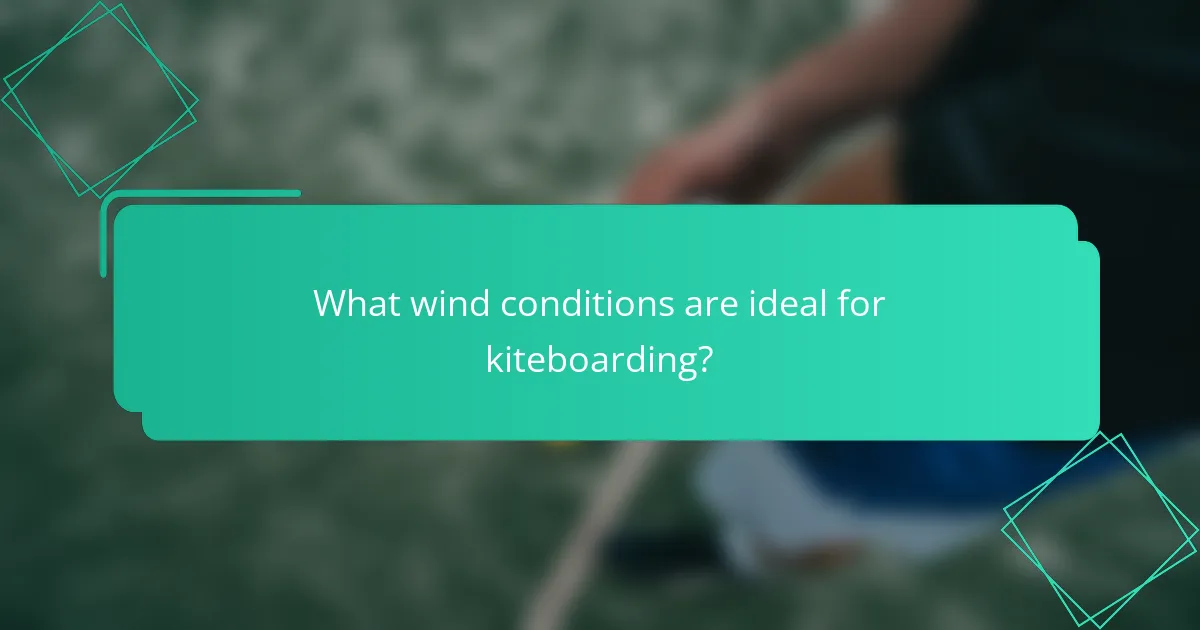
What wind conditions are ideal for kiteboarding?
Ideal wind conditions for kiteboarding include consistent winds ranging from 12 to 25 knots. These winds provide the necessary lift and control for optimal performance. Stronger winds may require specific equipment adjustments to ensure safety and effectiveness. Locations with steady cross-shore or onshore winds are preferred, as they enhance safety and accessibility.
How do different wind speeds affect kiteboarding performance?
Different wind speeds significantly impact kiteboarding performance. Optimal wind conditions enhance speed and control, while extreme winds can lead to safety hazards.
Light winds, typically under 12 knots, require larger kites for effective lift. These conditions are ideal for beginners, allowing for easier handling. Moderate winds, between 12 and 20 knots, provide a balance, enabling experienced riders to perform tricks and maneuvers efficiently.
Strong winds, exceeding 20 knots, demand smaller kites to maintain control. These conditions can be exhilarating but pose risks, including equipment damage and injury. Riders must assess their skill level and equipment compatibility before venturing out in high winds.
Understanding wind conditions is crucial for maximizing performance and ensuring safety in kiteboarding.
Which wind directions are best for various locations?
The best wind directions for kiteboarding vary by location. Generally, onshore winds are ideal for beginners, while offshore winds suit experienced kiteboarders. Side-shore winds provide consistent conditions across many popular spots.
| Location | Best Wind Direction | Wind Type |
|——————-|———————|——————|
| Maui, Hawaii | Trade Winds | Consistent Onshore |
| Cabarete, Dominican Republic | Northeast | Steady Cross-Shore |
| Tarifa, Spain | Levante | Strong Onshore |
| Cape Town, South Africa | Southeast | Reliable Side-Shore |
What are the seasonal wind patterns in popular kiteboarding regions?
Seasonal wind patterns in popular kiteboarding regions vary significantly. In summer, locations like Cape Hatteras experience consistent trade winds averaging 15-25 knots. In contrast, winter months in the Caribbean bring lighter winds, around 10-15 knots, ideal for beginners. Regions like Tarifa see strong winds year-round, peaking in spring and fall. These seasonal variations influence equipment choice and safety practices. Understanding local wind patterns enhances the kiteboarding experience.
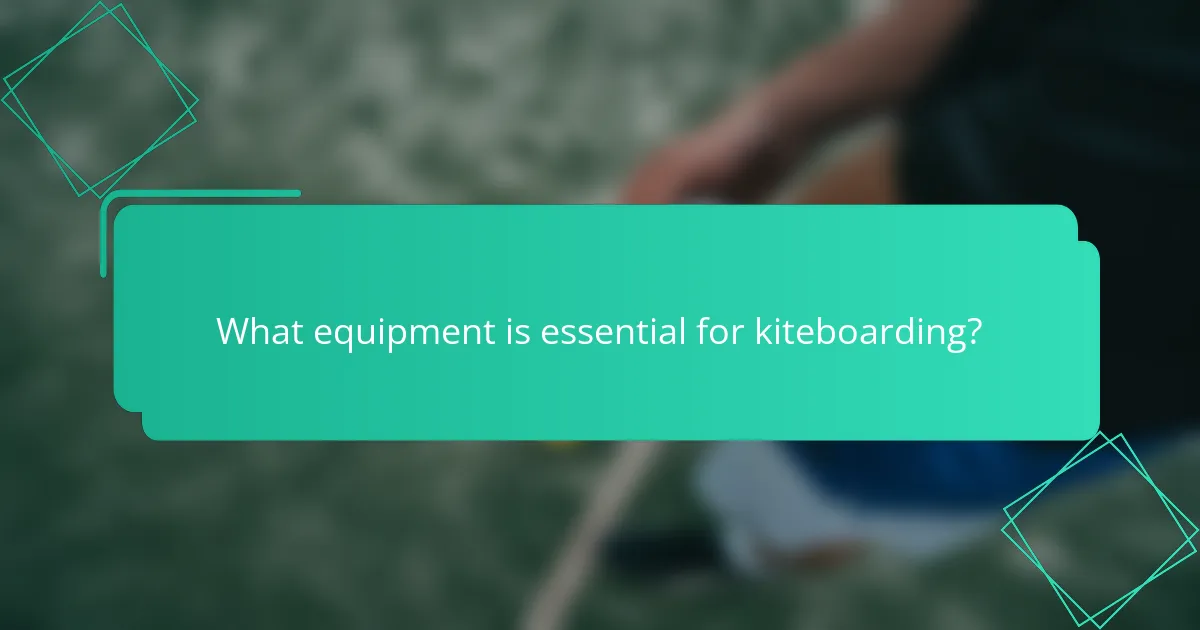
What equipment is essential for kiteboarding?
Essential equipment for kiteboarding includes a kite, control bar, harness, board, and safety leash. Each component is crucial for performance and safety.
The kite varies in size and type based on wind conditions and rider skill. The control bar connects the rider to the kite, allowing for steering and control. The harness secures the rider to the control bar, distributing the pull from the kite. The board provides the platform for riding on water. A safety leash is vital for detaching the kite in emergencies, ensuring rider safety.
Investing in quality equipment enhances the kiteboarding experience and promotes safety on the water.
Which types of kites are available and how do they differ?
Kiteboarding features various types of kites, each designed for specific wind conditions and skill levels. The main types include inflatable kites, which provide stability and are suitable for beginners; foil kites, known for their efficiency in light winds; and hybrid kites, which combine features of both for versatility. Inflatable kites typically have a larger surface area, making them ideal for jumping and tricks, while foil kites excel in low wind due to their aerodynamic design. Hybrid kites offer a balance of performance and ease of use, appealing to a wide range of riders.
What are the key components of a kiteboarding setup?
A kiteboarding setup comprises a kite, control bar, harness, board, and safety equipment. The kite generates lift and propulsion, while the control bar allows steering. The harness connects the rider to the kite, and the board provides stability and maneuverability. Safety equipment includes a quick-release system and impact vest. Proper wind conditions are crucial for an effective setup.
How do conditions influence equipment selection?
Wind conditions significantly influence equipment selection in kiteboarding. Higher wind speeds necessitate smaller kites and more robust boards, while lighter winds require larger kites for adequate lift. Additionally, wind consistency impacts the choice of gear; unpredictable gusts may lead to selecting more versatile equipment to handle varying conditions. Understanding local wind patterns helps riders optimize their setup for safety and performance.
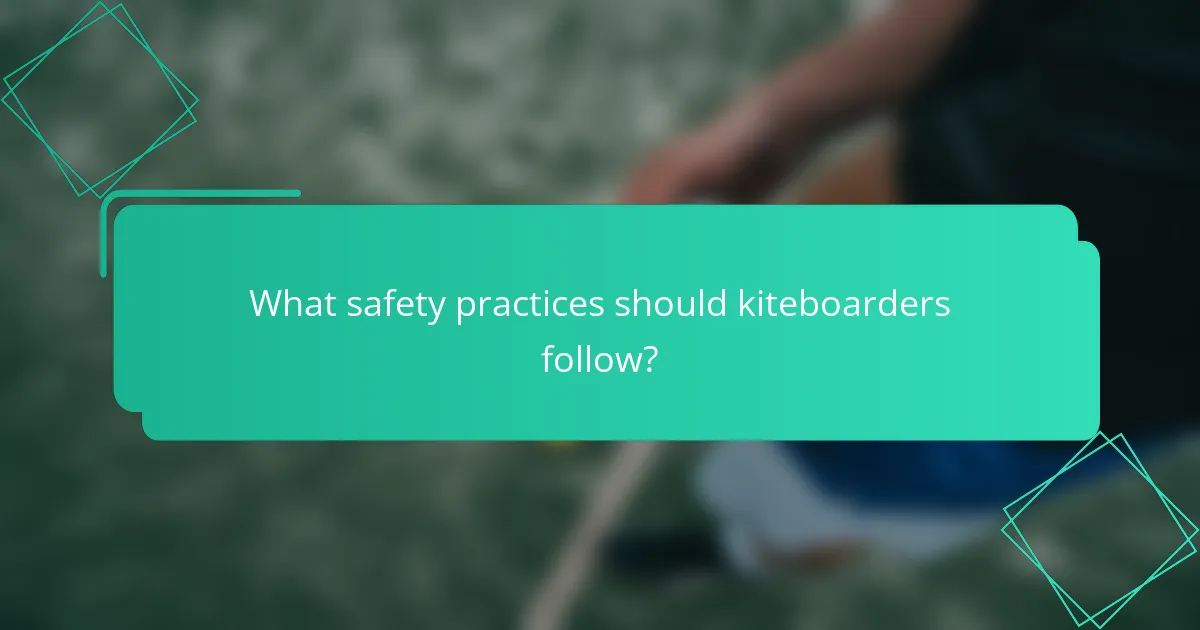
What safety practices should kiteboarders follow?
Kiteboarders should follow essential safety practices to ensure a safe experience. Always wear a personal flotation device and a helmet. Check equipment for wear and tear before use. Understand local wind conditions and avoid crowded areas. Use a quick-release mechanism on the harness to detach in emergencies. Stay aware of surroundings and communicate with other riders. Regularly practice self-rescue techniques to enhance safety.
How can kiteboarders assess and manage risks?
Kiteboarders can assess and manage risks by evaluating wind conditions, using appropriate equipment, and following safety practices. Understanding local weather patterns helps predict changes in wind strength and direction. Essential equipment includes a reliable kite, board, and safety gear like a harness and helmet. Practicing safety measures, such as checking equipment before use and knowing emergency procedures, reduces the likelihood of accidents. Regularly attending kiteboarding clinics can enhance skills and awareness of potential hazards.
What are common injuries and how can they be prevented?
Common kiteboarding injuries include sprains, fractures, and lacerations. Preventing these injuries involves using proper equipment, understanding wind conditions, and adhering to safety practices. Wearing a helmet and impact vest reduces injury risk. Regularly inspecting gear ensures safety and functionality. Training with a certified instructor enhances skills and awareness, decreasing accident likelihood. Understanding local conditions helps kiteboarders navigate potential hazards effectively.
Which safety gear is recommended for beginners versus experienced kiteboarders?
Beginners should use a helmet, impact vest, and a leash; experienced kiteboarders can opt for specialized gear like a buoyancy vest and advanced harnesses. Safety gear varies significantly based on skill level. Beginners need basic protection to mitigate risks, while experienced riders may choose equipment that enhances performance and safety in challenging conditions.
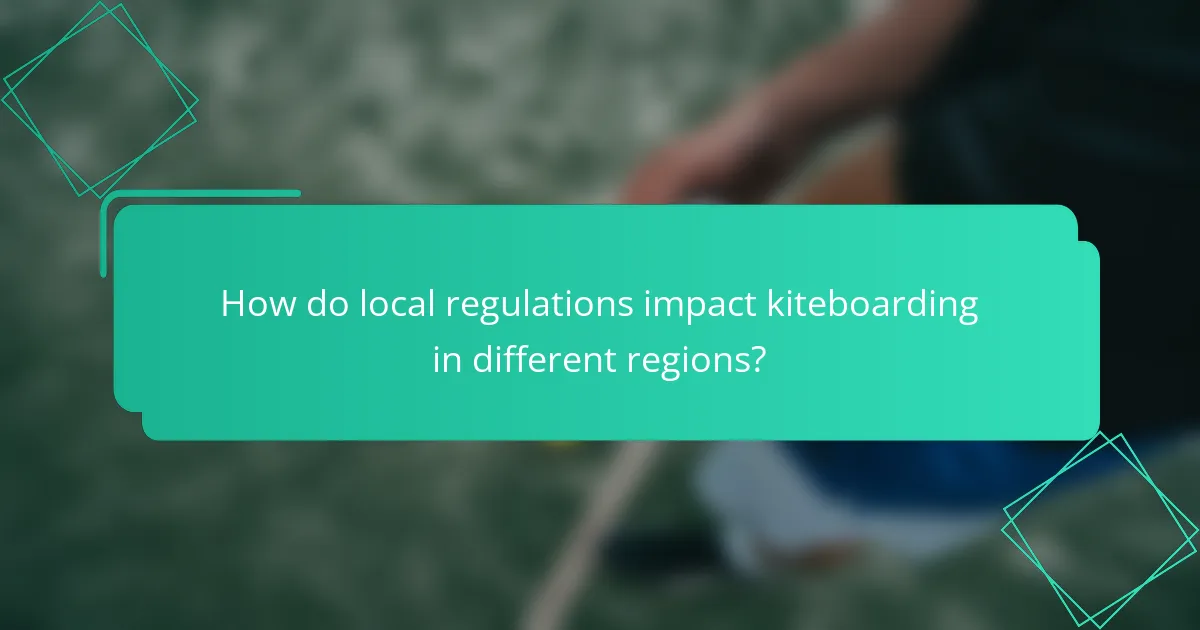
How do local regulations impact kiteboarding in different regions?
Local regulations significantly influence kiteboarding through restrictions on locations, equipment usage, and safety requirements. Different regions may have specific rules regarding kiteboarding zones, wind conditions, and environmental protections. For instance, some areas may prohibit kiteboarding during certain seasons to protect wildlife or minimize conflict with other water activities.
Safety practices are often mandated by local authorities, including the use of personal flotation devices and adherence to designated launch and landing areas. Equipment regulations may also vary; certain regions might require specific kite sizes or types based on local wind conditions. Understanding these regulations is crucial for kiteboarders to ensure compliance and enhance safety while enjoying the sport.
What are the common legal requirements for kiteboarding in Canada?
Kiteboarding in Canada requires compliance with local regulations, including safety equipment and liability insurance. Common requirements include wearing a personal flotation device, using a kite leash, and following local access rules. Additionally, some regions may mandate kiteboarding licenses or permits. Always check specific provincial guidelines to ensure compliance.
How do kiteboarding regulations vary between the UK and the US?
Kiteboarding regulations differ significantly between the UK and the US, primarily regarding safety requirements and location restrictions. In the UK, kiteboarders must adhere to guidelines set by the Royal Yachting Association, emphasizing safety gear and local wind conditions. In contrast, the US has a more decentralized approach, with regulations varying by state and location, often influenced by local conditions and community standards.
| Aspect | UK Regulations | US Regulations |
|———————-|———————————————–|————————————————|
| Safety Gear | Mandatory use of helmets and impact vests | Varies by state; often recommended but not mandatory |
| Location Restrictions | Specific areas designated for kiteboarding | Local regulations dictate available kiteboarding spots |
| Insurance Requirements| Not mandatory, but recommended | Varies; some locations may require liability insurance |
| Training Standards | Encouraged to have formal training | Recommendations vary; some areas may require certification |
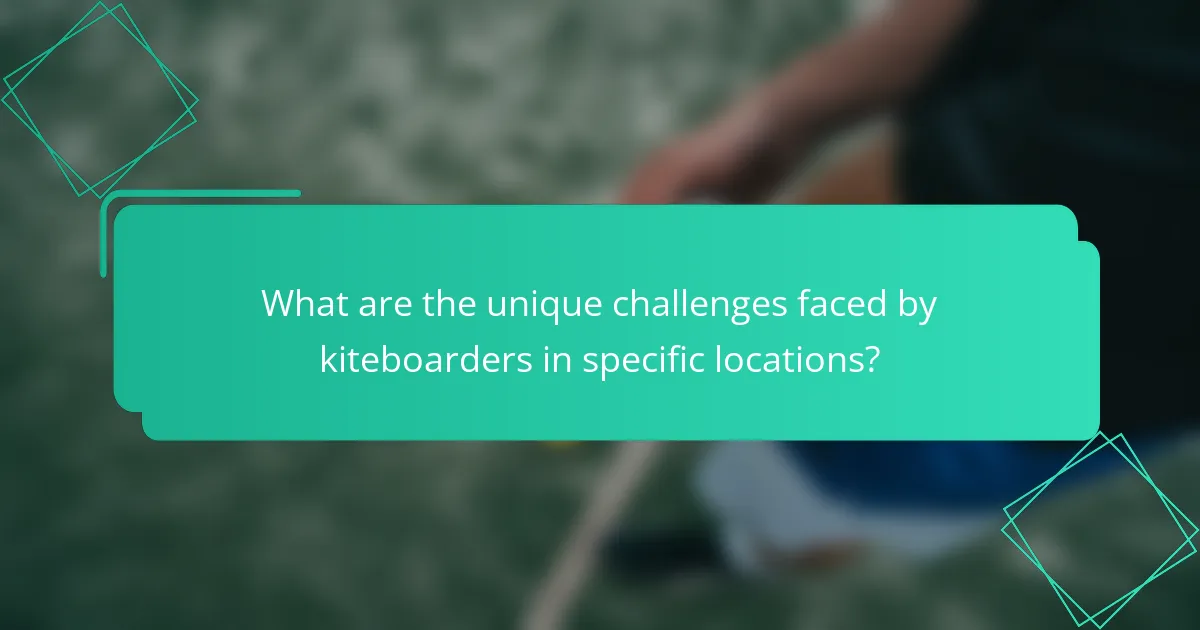
What are the unique challenges faced by kiteboarders in specific locations?
Kiteboarders face unique challenges based on wind conditions, local regulations, and geographical features. Locations with inconsistent winds can hinder performance, while crowded beaches may complicate navigation. Additionally, varying water conditions, such as waves or currents, require specific equipment adjustments. Safety practices also vary; some regions mandate life jackets or specific signaling devices. Understanding these factors enhances kiteboarding experiences and promotes safety.
How do geographical features influence kiteboarding conditions?
Geographical features significantly affect kiteboarding conditions by influencing wind patterns, water currents, and wave sizes. Coastal areas with open water typically provide consistent winds, while mountains can create turbulence. Flat, shallow waters are ideal for beginners, while wave-rich locations cater to advanced riders. Additionally, seasonal changes in weather patterns can alter conditions, making some locations more favorable at different times of the year. Understanding these geographical influences helps kiteboarders choose the best spots for their skill level and desired experience.
What cultural factors affect kiteboarding communities around the world?
Cultural factors significantly influence kiteboarding communities globally. Local traditions shape the popularity and style of kiteboarding, impacting equipment choices and safety practices. For instance, regions with strong wind conditions often develop unique community events and competitions that reflect local culture. Additionally, safety practices may vary based on local regulations and environmental awareness, affecting how communities approach kiteboarding. The integration of cultural values fosters a sense of belonging and identity among kiteboarders, enhancing their overall experience.
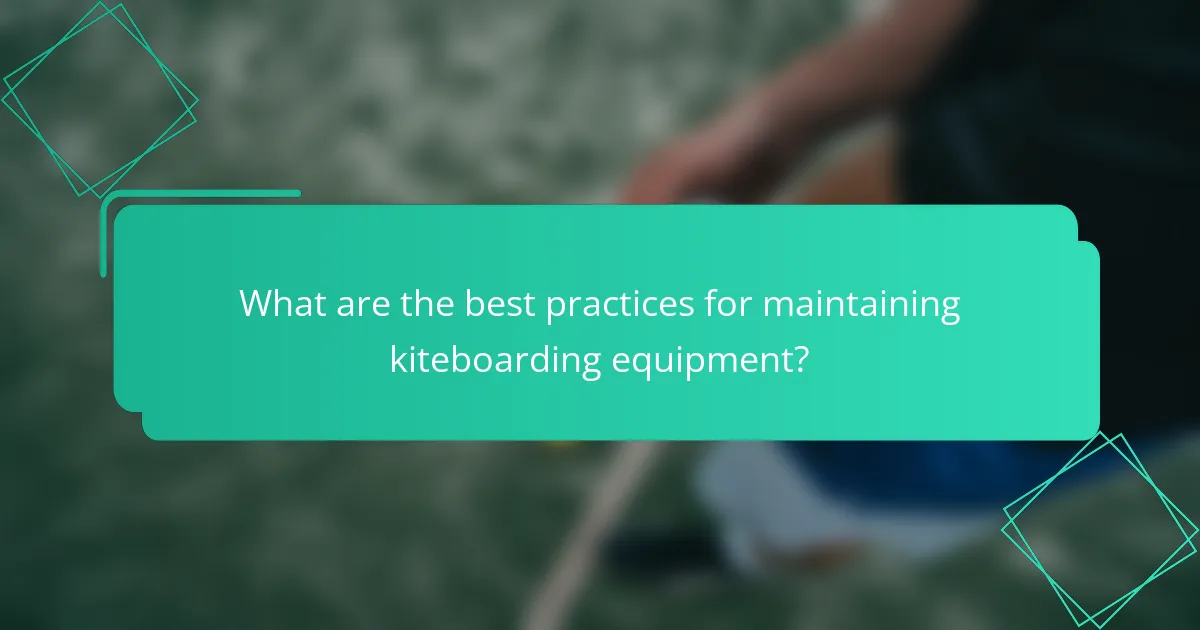
What are the best practices for maintaining kiteboarding equipment?
Regular maintenance of kiteboarding equipment ensures longevity and performance. Key practices include cleaning gear after each session, inspecting for damage, and storing in a cool, dry place.
1. Rinse equipment with fresh water to remove salt and sand.
2. Check lines for fraying or knots; replace if damaged.
3. Inspect the kite for leaks or tears; patch as needed.
4. Store the board and kite flat to avoid warping.
5. Keep the harness clean and check buckles for wear.
Following these practices enhances safety and enjoyment while kiteboarding.
How can kiteboarders extend the lifespan of their gear?
Kiteboarders can extend the lifespan of their gear by following proper maintenance practices. Regularly rinse equipment with fresh water after use to remove salt and sand. Store kites in a cool, dry place away from direct sunlight to prevent material degradation. Inspect lines and hardware for wear, replacing any damaged components promptly. Use protective covers when transporting gear to avoid abrasions. Additionally, follow manufacturer guidelines for maintenance and repairs to ensure optimal performance and longevity.
What common mistakes should be avoided when caring for equipment?
Avoiding common mistakes in equipment care is crucial for kiteboarding safety and performance. Key errors include neglecting regular maintenance, using inappropriate storage methods, and overlooking equipment inspections.
1. Failing to clean gear after use can lead to corrosion and damage.
2. Not checking for wear and tear may result in equipment failure during use.
3. Improperly storing kites and boards can cause deformation and reduce lifespan.
4. Ignoring manufacturer guidelines for repair and maintenance can void warranties.
By addressing these mistakes, kiteboarders enhance their equipment’s durability and ensure safer experiences on the water.
